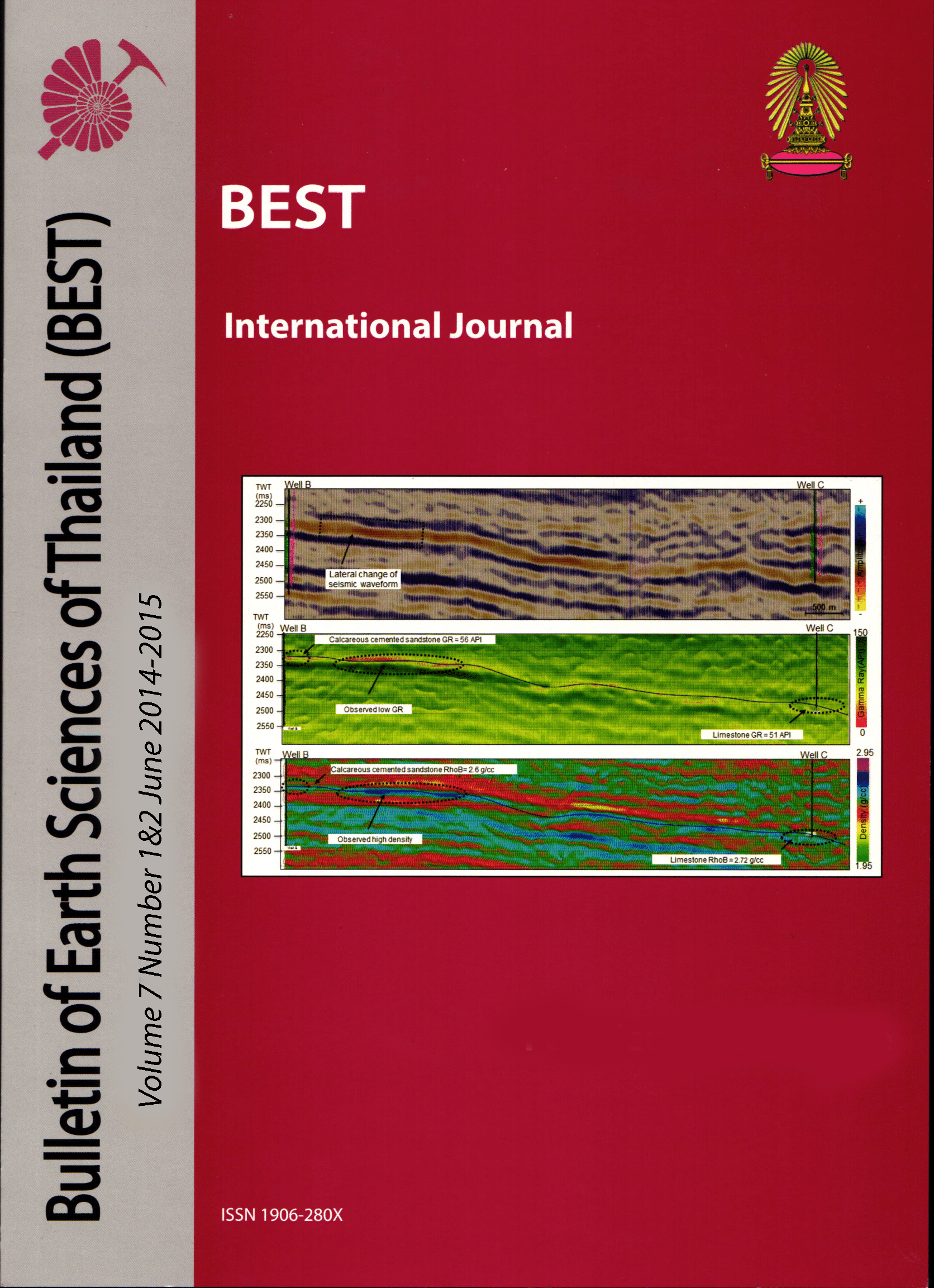An isotopic and sedimentological study of deepwater carbonates Lobburi, Central Thailand
Main Article Content
Abstract
The present study is concerned with the application of sedimentological and geochemical isotope analysis approaches in order to predict the depositional environment, fluid evolution history and reservoir rock
property alteration, tied to burial and uplift of Permian basinal and platform margin sediments in outcrops in central Thailand (UTM: X:705100;707000 and Y:168600;1627400).Three representative measured
section were constructed, two in a mixed carbonate-siliciclastic interval and one in a sequence of intercalated hemipelagic mud-volcaniclastics. A combination of field observation and laboratory analysis established three distinct lithofacies, namely: a) mud-wackestone, b) wacke-packstone and C) grainstone (rudstone). Multiple diagenetic features were observed microscopically and most are related to a progressive burial (mesogenetic) evolution. Stylolite dissolution seams and penetrative grain-to-grain
contact features account for significant losses in reservoir rock porosity with complete matrix permeability once the succession under study attained deeper burial domains. Related to this evolution the stable isotopic signatures shows two distinct field behaviors in a C-O covariant crossplot that defines two separate plot fields for the sampled matrix and calcite veins. Two different timings/stages of calcite veins were also identified based related to calcite stabilization in earlier versus later burial and likely indicate mesogenetic calcite formed from earlier somewhat (cooler) and somewhat later (warmer) burial fluids.
Article Details

This work is licensed under a Creative Commons Attribution-NonCommercial-NoDerivatives 4.0 International License.
Copyright © 2008 Department of Geology, Faculty of Science, Chulalongkorn University. Parts of an article can be photocopied or reproduced without prior written permission from the author(s), but due acknowledgments should be stated or cited accordingly.
References
Ahr, Wayne M., 2008, Geology of carbonate reservoirs: the identification, description and characterization of hydrocarbon reservoirs in carbonate rocks. John
Coe, A. L. (edt.), 2010, Geological field techniques: Milton Keyes, UK, Wiley-Blackwell, 323 p.
Embry, A.F. and Klovan, J.E., 1971, A late Devonan Reef Tract on North Eastern Island, NorthWest Territories. p. 9-10
Flügel, E., 2010. Microfacies of Carbonate Rocks: Analysis, Interpretation and Application. Springer, Heidelberg, p. 984
Ludwig, 2014, An integrated isotopebased fluid evolution and rock typing study, based on well cuttings and outcrop in Permian and Triassic successions of central and north east Thailand. MSc. Thesis, Chulalogkorn University.
Moore, C.H., 2001. Carbonate Reservoirs e Porosity Evolution and Diagenesis in a Sequence Stratigraphic Framework, vol. 55. Elsevier, p. 444.
Scholle, Peter A., and Dana S. UlmerScholle. A Color Guide to the Petrography of Carbonate Rocks: Grains, Textures, Porosity, Diagenesis, AAPG Memoir 77.
Susanto, W., 2010, Diagenetic and isotope evolution recorded in calcite cements in a large Indonisian fault zone in Permian platform- interior carbonates of Northeast Thailand: Master thesis of Chulalongkorn University, Bangkok, Thailand, 83 pp
Tucker, Maurice E., and V. Paul Wright., 2009.Carbonate sedimentology. John Wiley & Sons,
Tucker, M. E., 2003, Sedimentary Rocks in the Field (Geological Field Guide), Wiley Sci, p.244.
Warren, J., C. K. Morley, T. Charoentitirat, I. Cartwright, P. Ampaiwan, P. Khositchaisri, M. Mirzaloo, and J. Yingyuen, 2014, Structural and fluid evolution of Saraburi Group sedimentary carbonates, central Thailand: A tectonically driven fluid system: Marine and Petroleum Geology, v. 55, p. 100-121.


